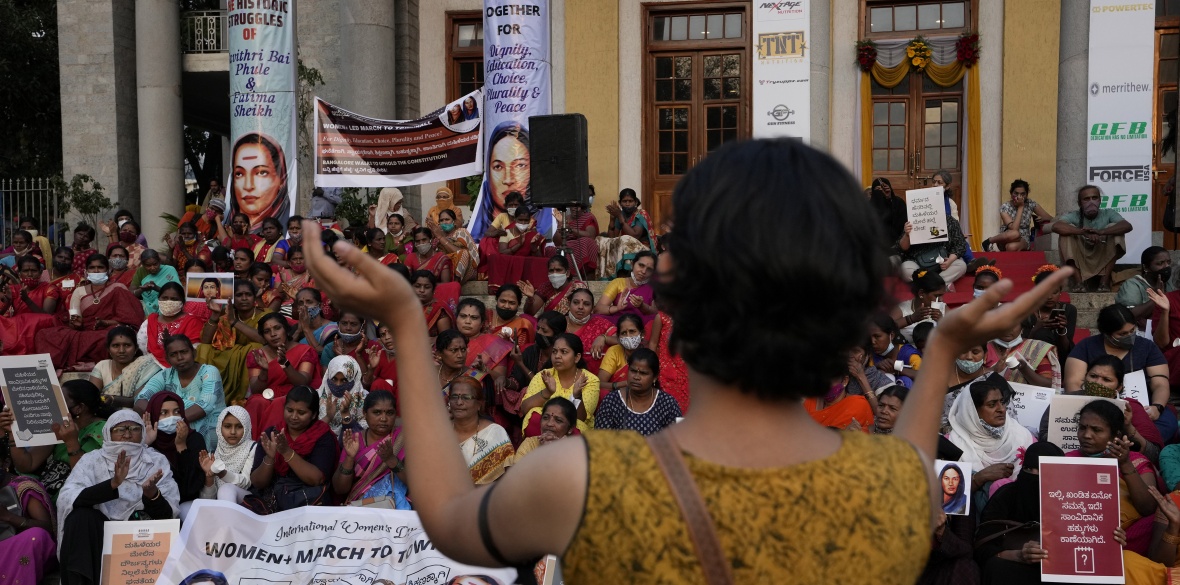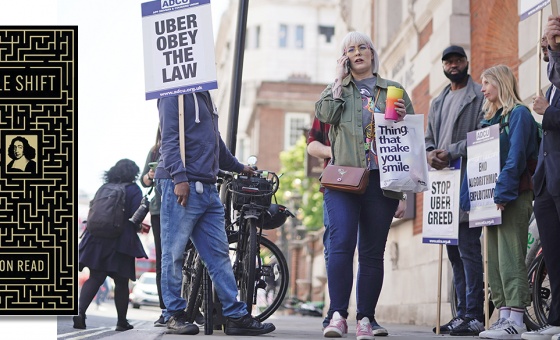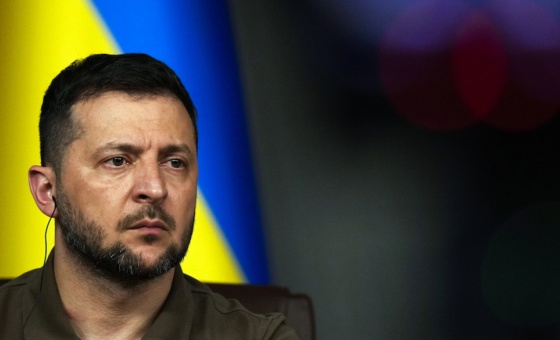This is the last article you can read this month
You can read more article this month
You can read more articles this month
Sorry your limit is up for this month
Reset on:
Please help support the Morning Star by subscribing here
WE COMMEMORATE victims of the Holocaust as we do genocide victims by many tyrants.
Hiroshima and Nagasaki by the US and atrocities by the empire. Do we stop and think about the day-to-day tyranny women face?
Judging by the available data, sexual violence can be responsible for an overwhelmingly higher number of lives lost than in multiple genocides put together.
Female genocide does not begin or end in mass numbers, but adds up to mass murder by daily and slow killings through patriarchal habits, customs and practices.
Girls are trained from birth to accept subordinate and subservient to men is their destiny.
Glorified stories of epics such as those of Sita and Rama and fairy tales such as Beauty and the Beast condition women to tolerate violence and hardship, for which they shall be rewarded.
These norms are reinforced by all ancient religious teachings such as Manu smriti — Hindu laws — the rejected rule book that the current Indian government is moving to reintroduce.
Female genocide takes place both before and after birth. Killing a female child at birth and female foeticide is a centuries-old practice in the Indian subcontinent, China and some former Soviet Union countries.
The sex ratio recorded in India in 2020 was 108.18 males per 100 females (48.4 females, 51.96 males).
In the same year, the ratio in Kerala has been recorded to be 47.98 per cent males to 52.2 per cent females. Sabu George, an activist and researcher, estimates that India has killed 2.6 million girls between 2015 and 2021.
Despite the Indian Prime Minister Narendra Modi’s call for “Beti bachao, Beti padao” (save and educate daughters) socio-economic conditions for girls and women have worsened.
Baby and toddler girls are found abandoned at the doorsteps of many places of worship, in dustbins, in shallow graves and floating in some rivers.
According to the government’s annual economic survey in January 2018, 63 million women are missing from Indian population due to disease, malnourishment, female foeticide and neglect.
Another 23 million girls are believed to be unwanted by their parents. We see a similar or worse picture in many other Asian countries. Qatar and the UAE are the ones worst for gender gap.
With social transformation of matrilineal to patrilineal (patriarchy) and the development of private property, women too have become private property of men.
In the pretext of female fidelity, their right to freedom and economic independence they once enjoyed has been removed.
Due to not having a means of income, a vast majority of women worldwide are forced to live at the mercy of their male relations and are pushed into extreme poverty.
Prior to the outlawing of Sati in the 18th century, many widows in India were burnt alive on their deceased husbands’ pyres.
Those who escaped this practice were forced to observe religious rituals that were degrading their dignity and integrity.
Despite laws prohibiting these religious practices they are closely followed in many parts of India. Widows’ heads are shaven, jewellery is removed and they are allowed only one meal a day.
Being considered bad luck to others, widows are forced to live a solitary life and are deprived of all comforts of life.
Despite having legal protection, Indian widows are denied the right to inherit their deceased husbands’ property by the male relations, including their sons, at the mercy of whom they exist.
They are often abandoned or thrown out. Thus they are forced into extreme poverty. Many end up in Varanasi — a Hindu holy city — where they earn a living by begging, singing religious songs and many end up becoming prostitutes — Dev Dasies (God’s servants).
Without a doubt Indian society is moving away from these religious practices and is leaving many of these demeaning and regressive customs, but it is a very slow process that needs to be fast-tracked.
There are many parallel practices found in African sub-Saharan countries. Due to frequent child marriage and large age gaps between husbands and wives, one in 10 African women are widowed at the age of 14 and above.
Like their Indian counterparts they too are deprived of means of production and are prevented from inheriting their deceased husbands’ property and assets.
Thus they fall into extreme poverty. Degrading and humiliating religious and cultural practices shatter their personal dignity and self-respect.
They are forced to live in confinement for an extended mourning period that can be up to a year, during which they are not allowed to take a bath, change clothes or eat nutritious meals.
The most degrading practice for the African widow is to undergo a requisite cleansing by which they have to have unprotected sex with her diseased husband’s brother or another of his male relatives or with a professional cleanser to “remove the impurities.”
Increasing violence against women
Violence against women often is invisible but widespread crime that violates their human rights. According to UN Women, more than one in three women (35 per cent) worldwide experience physical, emotional and/or sexual violence in their lifetime.
Disabled, lower-caste and lower-class women are much more like to experience sexual violence. The same source reveals that 15 million adolescent girls fall victims of forced sex and 200 million women have undergone FGM — pain they have bear for life that can cause death, especially at childbirth.
According to the Office for National Statistics, a total of 152,620 sexual assaults in England and Wales were recorded in the 12 months to September 2020, out of which 56,119 were rape cases that have been increased to 63,136 in the following 12 months.
However only 1.3 per cent suspected were charged. In contrast, according to National Crime Record Bureau (India), on average 88 rapes a day are committed in India but just over 27 per cent end in conviction.
These figures are a tip of iceberg. Due to embarrassment and family honour, a majority of cases escape statistics.
Less than 40 per cent of women who experience violence seek formal help and support, while other look for support from their family and friends.
A study by the United Nations in 2019 revealed that six women worldwide are killed every hour by a male relative, but only 76 countries have legislation that specifically addresses domestic violence and just 57 of them include sexual abuse as form of violence against women.
The latest report by the Homicide Census shows that one woman is killed every three days by a man in the UK. Sixty-two per cent of them were killed by their current or previous partners.
According to Global Citizens (July 2018), in India 20 women a day are either killed, burnt alive or commit suicide because of insufficient dowry.
The National Commission for Women revealed that it had received more that 19,000 complaints of crime against women in year 2019. That shot up to over 23,000 during the pandemic year 2020.
A quarter of the complaints were of domestic violence. A study by Unicef, Hidden in Plain Sight, states that nearly 42 per cent of Indian girls under the age of 19 have been subject to sexual abuse, while another survey carried by Thomson Reuters in June 2018 has signalled that because of high risk of sexual violence, abuse and harassment, India has become a most dangerous country for women to live in.
The study has indicated Indian women face a high risk of forced slave labour. Women’s social and economic status have rapidly declined under the administration of current Indian government.
Despite the prime minister’s scheme of calling parents to save and educate their daughters, women do not feel safe.
Sexual and physical violence has seriously increased in the last eight years. Legalised “love jihad” criminalised men and women choosing who they like to associate with, or whom they marry, especially if one partner is from the Islamic faith.
Online sexual abuse worldwide is shockingly high and in increasing. It has been proven to be highly harmful to teenage children.
In a review by Ofsted, British pupils stressed that sexual harassment and online sexual abuse have become such a routine of their life that they do not see a point in complaining.
Girls disproportionately suffer sexual name-calling, “upskirting,” unwanted touching and rape jokes in the school corridors and school buses.
Shockingly, nine out of 10 girls and half the boys who took part in the review said they have been sent indecent pictures.
For centuries women’s rights and social reformist movements all over the world have been declaring that denying women their human rights is a crime against humanity.
It is our duty and responsibility to join forces to take this struggle forward to ensure women’s human rights to exist, be visible, free from violence, inequalities and discrimination.
A challenge we must take to free women from religious and patriarchal customs and traditions that degrade women, deny their right to property, inheritance, equal opportunities for education, employment, health services and social, political and economic independence.
As well as take up these challenges, on International Women’s Day let us celebrate millions of global women who have challenged and are challenging the patriarchy, are refusing to be silent and quiescent, who refused to be ruled by social, cultural and religious customs and practices.
Let us celebrate women who are refusing to accept the blame for violence — that their behaviour is responsible for male violence, whether it be the clothes they wear, the time and location they are out and so on.
Let us celebrate women who have taken the challenge to reclaim our streets, to be fearlessly free. Let us celebrate Malala Yousafzai, Greta Thunberg, Disha Ravi — sisters who fearlessly challenged the world’s most powerful establishments.
Let us celebrate the women protesters of Shaheen Bagh in Delhi, university students and women of the year-long farmers’ struggle who have given a tough fight to the Modi-led BJP regime at the time when no-one dared to stand up to it.
Let us celebrate suffragette women who gave a long and harsh fight to win the female right to vote.
Let us celebrate Jayaben Desai and the women at the Dagenham Ford factory who challenged racism and inequalities at work in the 1970s.
Let us celebrate Chandro Tomer, who, at 89 years old, defied the age barrier to become a professional sharpshooter.
She was believed to be the oldest professional sharpshooter in the world and became a feminist icon in India. She mentored and coached dozens of young women in her village and beyond.
Let us celebrate all those women who took to sport against all types of opposition and threats from their local communities.
Let us also not forget to celebrate all those fathers, brothers and husbands who stood by their daughters, sister and wives and fought the feudal and patriarchal norms and values ensuring their daughters’, sisters’ and wives’ dreams come true.
Mahaveer Singh Phogat, who coached his two daughters, Geeta and Babita, to become professional in wrestling, Jotirao Phuley (Savitri Bai’s husband), Dwarkanath Ganguli and Braja Kishore Basu (Kadambini Gaguli’s husband and father respectively), Gopal Rao Joshi (Anandi Bai’s husband) are just a few names out of thousands others.











